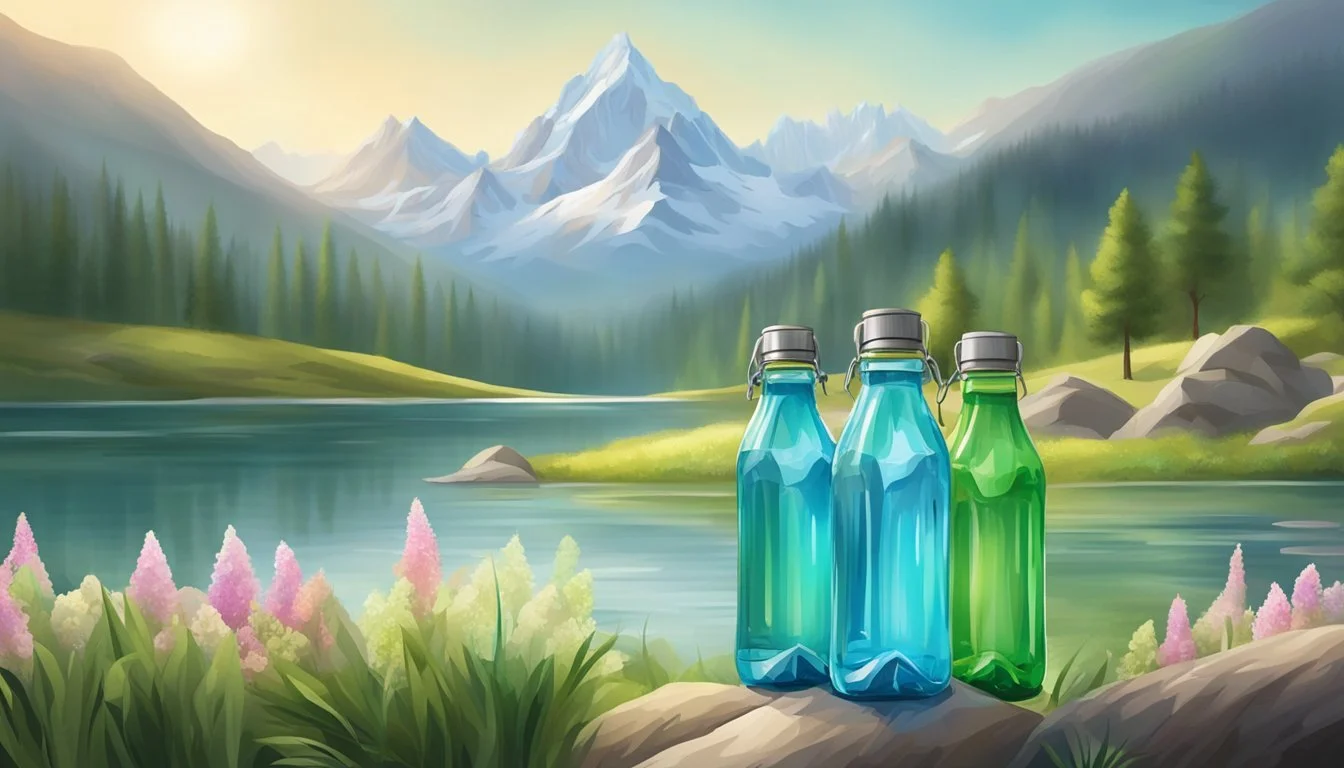Mountain Valley Spring Water vs. Cascade Mountain
A Comparative Analysis
When it comes to choosing between Mountain Valley Spring Water and Cascade Mountain, the debate often narrows down to purity, taste, and origin. Mountain Valley Spring Water, sourced from the Ouachita Mountains in Arkansas, boasts a reputation for its crisp, refreshing flavor and minimal mineral content. Cascade Mountain, on the other hand, prides itself on being derived from the pristine springs of the Cascade Range, offering a similarly pure but subtly distinct taste profile.
Mountain Valley Spring Water is often considered superior due to its rich history and consistent quality, which has earned it numerous awards, including accolades at the Berkeley Springs International Water Tasting. Despite this strong endorsement, Cascade Mountain still garners a dedicated following for its unique minerality and exceptional clarity.
Readers interested in understanding which bottled water reigns supreme will find this comparison insightful, as it dissects the attributes that set these two premium brands apart. Whether you prioritize taste, source, or reputation, this analysis aims to shed light on the best choice for your hydration needs.
The Essence of Bottled Water
Bottled water, especially spring water, offers unique qualities and rigorous safety standards that ensure a consistent and clean drinking experience. This section explores the definitions, the process from source to bottle, and the standards that guarantee water quality and safety.
Defining Spring Water and Bottled Water
Spring water originates from natural springs, collected directly without significant alteration. It is often valued for its natural minerals and purity. Bottled water encompasses various types, such as spring water, mineral water, and purified water.
Each type caters to different preferences and needs:
Spring Water: Sourced from natural springs, often rich in minerals.
Mineral Water: Contains specific levels of minerals, usually beneficial.
Purified Water: Subjected to purification processes to remove contaminants.
Understanding these categories helps differentiate the types of bottled water available.
The Journey from Source to Bottle
The process of bringing bottled water from the source to the bottle involves several critical steps. It starts with sourcing water from a spring or other source. This water is transported to a bottling facility where it undergoes treatment to ensure safety and quality.
Key stages include:
Collection: Directly from the source.
Filtration: Removal of any particulates.
Treatment: Ensures no harmful microorganisms exist.
Bottling: In controlled environments to maintain purity.
This meticulous process guarantees that the bottled water remains clean and fresh for consumers.
Water Quality and Safety Standards
Bottled water is subject to strict regulatory standards to ensure its safety and quality. Organizations like the FDA in the United States regulate bottled water. These standards require regular testing for contaminants like bacteria, heavy metals, and chemicals.
Essentials of water quality:
Consistent Testing: Regular checks for contaminants.
Clear Labeling: Transparency about the source and contents.
Compliance with Regulations: Adherence to national and international safety standards.
These measures provide consumers with confidence in the bottled water they choose, reaffirming its integrity and safety for drinking.
Historical Background
Understanding the origins of Mountain Valley Spring Water and Cascade Mountain provides insights into their unique qualities and trustworthiness as a choice for bottled water. Their histories are rooted in distinct locations and have evolved over time to meet consumer needs.
Mountain Valley Spring Water's Heritage
Mountain Valley Spring Water originates from Hot Springs, Arkansas. Established in 1871, it has a legacy spanning over 145 years. The water is sourced from the pristine Ozark Mountains and is known for its purity and balanced mineral composition.
Since its inception, Mountain Valley Spring Water has maintained a reputation for premium quality. The brand has become synonymous with health and wellness, often favored by chefs and health enthusiasts alike. Bottled in its iconic green glass bottle, it continues to draw from its original spring, ensuring consistency and trust.
Cascade Mountain's Roots and Development
Cascade Mountain, though less historically established compared to Mountain Valley, has quickly gained recognition for its high-quality spring water sourced from the Cascade Mountain range. Founded in the early 20th century, it has carved out a niche with a focus on sustainability and innovation.
The brand emphasizes environmentally friendly practices, from sustainable sourcing to eco-conscious packaging. Cascade Mountain’s development reflects a modern approach to bottled water, balancing quality with environmental responsibility. Its rapid growth and commitment to sustainability make it a notable competitor in the premium bottled water market.
Profile Analysis
Mountain Valley Spring Water and Cascade Mountain offer distinct profiles, focusing on their unique composition, mineral content, taste profile, and pH levels. Understanding these aspects helps consumers make informed choices about their bottled water preferences.
Composition and Mineral Content
Mountain Valley Spring Water and Cascade Mountain differ in their mineral compositions, which contribute to their unique health benefits and flavors.
Mountain Valley boasts a rich mineral content, highlighting magnesium, calcium, and low sodium levels. Magnesium and calcium are crucial for bone health and muscle function, making this water a good choice for those seeking these nutrients.
Cascade Mountain, on the other hand, emphasizes its purity and natural filtration process. It generally contains lower mineral quantities but retains essential electrolytes like potassium. This may appeal to individuals focusing on hydration without excessive mineral intake.
Taste Profile and Palette
The taste profiles of Mountain Valley and Cascade Mountain reflect their unique sources and mineral compositions.
Mountain Valley Spring Water is often described as clean and slightly sweet, with a velvety texture. Its light mineral presence gives it a subtly distinct flavor that many people enjoy. This makes it suitable for everyday drinking and pairing with food.
Cascade Mountain water, sourced from pristine environments, tends to have a crisper and more neutral taste. This can be attributed to its lower mineral content, resulting in a refreshing and pure drinking experience. Its neutral palette makes it versatile for various occasions, including fitness and daily hydration.
PH Levels and Alkalinity
pH levels and alkalinity are critical factors for those concerned with the acid-alkaline balance in their diet.
Mountain Valley Spring Water typically has a pH around 5, placing it on the acidic side of the scale. This might surprise some, given its mineral richness, but it aligns with its natural sourcing and minimal processing.
Cascade Mountain water often features a pH closer to neutral, generally around 7. This neutrality appeals to those seeking balanced pH levels in their water. Its alkalinity can support better acid-base balance in the body, which is important for overall health.
These distinct profiles highlight how both waters cater to different preferences and dietary needs.
Environmental Impact
Mountain Valley Spring Water and Cascade Mountain each have distinct environmental practices. This section examines their bottling processes, packaging choices, and conservation efforts in detail.
Bottling Process and Sustainability
Mountain Valley Spring Water sources its water from natural springs. The company emphasizes eco-friendly practices by using BPA-free and glass bottles. They focus on reducing plastic waste. Packaging and transportation contribute minimal carbon emissions due to their streamlined processes.
Cascade Mountain, on the other hand, opts for local sourcing to minimize the environmental footprint caused by long-distance transportation. They employ recyclable materials and have initiatives aimed at reducing overall carbon emissions during bottling and distribution.
Glass vs. Aluminum: Packaging Choices
Mountain Valley Spring Water predominantly uses glass bottles, which are recyclable and can be reused. Glass is seen as an environmentally friendly option as it reduces plastic waste. The company’s choice of packaging underlines its commitment to sustainability and minimizing plastic usage.
In contrast, Cascade Mountain opts for aluminum bottles, which are also environmentally friendly. Aluminum is highly recyclable and has a lower carbon footprint compared to plastic. This choice of packaging reflects an emphasis on both durability and environmental conservation.
The Fountain of Earth’s Conservation
Mountain Valley Spring Water invests in conservation projects aimed at maintaining natural spring sources. They collaborate with environmental groups to preserve water quality and surrounding ecosystems. This approach reinforces their dedication to sustainable practices and protecting natural resources.
Cascade Mountain focuses on community-driven conservation efforts. They allocate funds to local environmental initiatives and promote conservation education. Their work ensures the sustainability of water sources and benefits the broader community through resources and awareness programs.
Both companies illustrate a commitment to environmental responsibility through their bottling processes, packaging choices, and conservation efforts. This comprehensive approach highlights their dedication to mitigating environmental impacts while providing high-quality bottled water.
Comparative Analysis
In comparing Mountain Valley Spring Water and Cascade Mountain, several important aspects must be considered. Taste, health benefits, and market recognition are crucial to determining which bottled water stands out.
Taste Tests and Expert Opinions
Mountain Valley Spring Water is often praised for its clean and subtly sweet taste. It has a velvety texture, which is highly appealing among consumers and water sommeliers. In contrast, Cascade Mountain boasts a crisp and refreshing palate, with a slightly higher mineral content giving it a distinctive flavor.
Expert opinions lean towards Mountain Valley for its balanced minerality, whereas the unique taste of Cascade Mountain attracts those preferring a more robust water profile. Both brands have their enthusiasts, highlighting the subjective nature of taste preferences.
Health Benefits Evaluation
Both Mountain Valley and Cascade Mountain are derived from natural sources, ensuring high levels of purity. Mountain Valley Spring Water is often celebrated for its low TDS (total dissolved solids) level, making it ideal for hydration with minimal risk of contaminants.
Cascade Mountain, known for its higher mineral content, provides essential electrolytes beneficial for active individuals. The pH levels of both waters are well within the safe range, with Mountain Valley showing slightly acidic properties occasionally. Cascade Mountain's neutral pH level caters to those seeking balanced alkalinity.
Market Standings and Awards
Mountain Valley Spring Water has a strong market presence, having been recognized multiple times at the Berkeley Springs International Water Tasting. Its award-winning status bolsters its reputation among consumers looking for the best bottled water.
Cascade Mountain, although less decorated, has built a robust market standing through consistent quality. It is steadily gaining recognition and has started to feature in premium bottled water rankings. The market support for both brands speaks to their commitment to quality and consumer satisfaction.
This comparison provides a clear perspective on what each of these bottled waters offers, aiding consumers in making an informed choice.
The Bottom Line: Selecting the Superior Water
Mountain Valley Spring Water and Cascade Mountain both offer distinct qualities that appeal to different consumer needs. This section assesses which option may come out on top based on hydration, health benefits, and environmental impact.
The Verdict for Hydration and Health
Mountain Valley Spring Water stands out for its natural mineral content and purity, sourced directly from an Arkansas spring. These minerals can aid in maintaining proper bodily functions and hydration levels. Many users praise its clean taste, indicative of its purity and beneficial mineral profile.
Cascade Mountain, sourced from pristine natural locations, also offers a refreshing hydration experience. However, specific mineral content details are less emphasized. Both brands provide good hydration, but Mountain Valley's transparency about its mineral contents gives it an edge for health-conscious consumers.
The Final Say on Environmental Footprint
Mountain Valley Spring Water is recognized for its environmentally friendly packaging, often using reusable glass bottles. This can significantly reduce plastic waste and promote sustainability. Their commitment to eco-friendly practices resonates with environmentally conscious consumers.
Cascade Mountain, while also advocating for sustainability, uses plastic bottles, which may not be as eco-favorable. Although many plastic bottles are recyclable, the environmental impact tends to be higher compared to glass. Mountain Valley's use of glass bottles makes it a more sustainable choice.
Overall Recommendation
For individuals prioritizing mineral content and purity in their hydration needs, Mountain Valley Spring Water is a top choice. Its clean taste and beneficial mineral profile support overall health and hydration efforts, especially for those who are health-conscious.
For those more concerned with environmental impact, Mountain Valley's commitment to reusable glass packaging sets it apart. Despite the convenience of plastic, the ecological benefits of glass packaging cannot be understated. Therefore, in the contest of which bottled water is superior, Mountain Valley Spring Water takes the lead.
More About Mountain Valley Spring Water
Acqua Panna vs Mountain Valley Spring Water: Which Bottled Water is Better?
Aquafina vs Mountain Valley Spring Water: Which Bottled Water is Better?
Arrowhead vs Mountain Valley Spring Water: Which Bottled Water is Better?
Bai vs Mountain Valley Spring Water: Which Bottled Water is Better?
Boxed Water vs Mountain Valley Spring Water: Which Bottled Water is Better?
Core Hydration vs Mountain Valley Spring Water: Which Bottled Water is Better?
Dasani vs Mountain Valley Spring Water: Which Bottled Water is Better?
Deer Park vs Mountain Valley Spring Water: Which Bottled Water is Better?
Essentia vs Mountain Valley Spring Water: Which Bottled Water is Better?
Eternal vs Mountain Valley Spring Water: Which Bottled Water is Better?
Ethos vs Mountain Valley Spring Water: Which Bottled Water is Better?
Evian vs Mountain Valley Spring Water: Which Bottled Water is Better?
Fiji vs Mountain Valley Spring Water: Which Bottled Water is Better?
Mountain Valley Spring Water vs HFactor: Which Bottled Water is Better?
Ice Mountain vs Mountain Valley Spring Water: Which Bottled Water is Better?
Icelandic Glacial vs Mountain Valley Spring Water: Which Bottled Water is Better?
Just Water vs Mountain Valley Spring Water: Which Bottled Water is Better?
LIFEWTR vs Mountain Valley Spring Water: Which Bottled Water is Better?
Mountain Valley Spring Water vs 1907water: Which Bottled Water is Better?
Mountain Valley Spring Water vs 7-Select: Which Bottled Water is Better?
Mountain Valley Spring Water vs Action: Which Bottled Water is Better?
Mountain Valley Spring Water vs Alkaline88: Which Bottled Water is Better?
Mountain Valley Spring Water vs Antipodes: Which Bottled Water is Better?
Mountain Valley Spring Water vs Aqua Carpatica: Which Bottled Water is Better?
Mountain Valley Spring Water vs Augi: Which Bottled Water is Better?
Mountain Valley Spring Water vs Big Chill: Which Bottled Water is Better?
Mountain Valley Spring Water vs Big Win: Which Bottled Water is Better?
Mountain Valley Spring Water vs Blk: Which Bottled Water is Better?
Mountain Valley Spring Water vs BodyArmor: Which Bottled Water is Better?
Mountain Valley Spring Water vs Castle Rock: Which Bottled Water is Better?
Mountain Valley Spring Water vs CBD Living: Which Bottled Water is Better?
Mountain Valley Spring Water vs Cirro: Which Bottled Water is Better?
Mountain Valley Spring Water vs Crystal Geyser: Which Bottled Water is Better?
Mountain Valley Spring Water vs Crystal Lake: Which Bottled Water is Better?
Mountain Valley Spring Water vs Defy: Which Bottled Water is Better?
Mountain Valley Spring Water vs Erewhon: Which Bottled Water is Better?
Mountain Valley Spring Water vs Essence pH10: Which Bottled Water is Better?
Mountain Valley Spring Water vs Flow: Which Bottled Water is Better?
Mountain Valley Spring Water vs Hawaii Volcanic: Which Bottled Water is Better?
Mountain Valley Spring Water vs Hawaiian Springs: Which Bottled Water is Better?
Mountain Valley Spring Water vs Kirkland Signature: Which Bottled Water is Better?
Mountain Valley Spring Water vs Kroger: Which Bottled Water is Better?
Mountain Valley Spring Water vs Liquid Death: Which Bottled Water is Better?
Mountain Valley Spring Water vs Mananalu: Which Bottled Water is Better?
Mountain Valley Spring Water vs Nestle Pure Life: Which Bottled Water is Better?
Mountain Valley Spring Water vs Open Water: Which Bottled Water is Better?
Mountain Valley Spring Water vs Ophora: Which Bottled Water is Better?
Mountain Valley Spring Water vs Origin: Which Bottled Water is Better?
Mountain Valley Spring Water vs Ozarka: Which Bottled Water is Better?
Mountain Valley Spring Water vs Path: Which Bottled Water is Better?
Mountain Valley Spring Water vs Penta: Which Bottled Water is Better?
Mountain Valley Spring Water vs Perrier: Which Bottled Water is Better?
Mountain Valley Spring Water vs Poland Spring: Which Bottled Water is Better?
Mountain Valley Spring Water vs Proud Source: Which Bottled Water is Better?
Mountain Valley Spring Water vs Purely Sedona: Which Bottled Water is Better?
Mountain Valley Spring Water vs Ramona: Which Bottled Water is Better?
Mountain Valley Spring Water vs Refreshe: Which Bottled Water is Better?
Mountain Valley Spring Water vs Richard's Rainwater: Which Bottled Water is Better?
Mountain Valley Spring Water vs San Pellegrino: Which Bottled Water is Better?
Mountain Valley Spring Water vs Simple Truth: Which Bottled Water is Better?
Mountain Valley Spring Water vs Skyra: Which Bottled Water is Better?
Mountain Valley Spring Water vs Smartwater: Which Bottled Water is Better?
Mountain Valley Spring Water vs Solan de Cabras: Which Bottled Water is Better?
Mountain Valley Spring Water vs Starkey: Which Bottled Water is Better?
Mountain Valley Spring Water vs Tahoe: Which Bottled Water is Better?
Mountain Valley Spring Water vs Talking Rain AQA: Which Bottled Water is Better?
Mountain Valley Spring Water vs The Well: Which Bottled Water is Better?
Mountain Valley Spring Water vs Topo Chico: Which Bottled Water is Better?
Mountain Valley Spring Water vs Tru Alka: Which Bottled Water is Better?
Mountain Valley Spring Water vs Volvic: Which Bottled Water is Better?
Mountain Valley Spring Water vs Voss: Which Bottled Water is Better?
Mountain Valley Spring Water vs Waiakea: Which Bottled Water is Better?
Mountain Valley Spring Water vs Weird Water: Which Bottled Water is Better?
Mountain Valley Spring Water vs Whole Foods 365: Which Bottled Water is Better?
Mountain Valley Spring Water vs Zenwtr: Which Bottled Water is Better?
Mountain Valley Spring Water vs Zephyrhills: Which Bottled Water is Better?
More About Cascade Mountain
Acqua Pana vs Cascade Mountain: Which Bottled Water is Better?
Antipodes vs Cascade Mountain: Which Bottled Water is Better?
Aqua Carpatica vs Cascade Mountain: Which Bottled Water is Better?
Aquafina vs Cascade Mountain: Which Bottled Water is Better?
Arrowhead vs Cascade Mountain: Which Bottled Water is Better?
Boxed Water vs Cascade Mountain: Which Bottled Water is Better?
Cascade Mountain vs 1907water: Which Bottled Water is Better?
Cascade Mountain vs 7-Select: Which Bottled Water is Better?
Cascade Mountain vs Alkaline88: Which Bottled Water is Better?
Cascade Mountain vs Big Chill: Which Bottled Water is Better?
Cascade Mountain vs BodyArmor: Which Bottled Water is Better?
Cascade Mountain vs CBD Living: Which Bottled Water is Better?
Cascade Mountain vs Crystal Geyser: Which Bottled Water is Better?
Cascade Mountain vs Crystal Lake: Which Bottled Water is Better?
Cascade Mountain vs Essence pH10: Which Bottled Water is Better?
Cascade Mountain vs Kirkland Signature: Which Bottled Water is Better?
Cascade Mountain vs Open Water: Which Bottled Water is Better?
Cascade Mountain vs Proud Source: Which Bottled Water is Better?
Cascade Mountain vs Pure Life: Which Bottled Water is Better?
Cascade Mountain vs Refreshe: Which Bottled Water is Better?
Cascade Mountain vs Richard's Rainwater: Which Bottled Water is Better?
Cascade Mountain vs Simple Truth: Which Bottled Water is Better?
Cascade Mountain vs Talking Rain AQA: Which Bottled Water is Better?
Cascade Mountain vs The Well: Which Bottled Water is Better?
Cascade Mountain vs Weird Water: Which Bottled Water is Better?
Cascade Mountain vs Whole Foods 365: Which Bottled Water is Better?
Castle Rock vs Cascade Mountain: Which Bottled Water is Better?
Core Hydration vs Cascade Mountain: Which Bottled Water is Better?
Deer Park vs Cascade Mountain: Which Bottled Water is Better?
Essentia vs Cascade Mountain: Which Bottled Water is Better?
Hawaii Volcanic vs Cascade Mountain: Which Bottled Water is Better?
Hawaiian Springs vs Cascade Mountain: Which Bottled Water is Better?
Ice Mountain vs Cascade Mountain: Which Bottled Water is Better?
Icelandic Glacial vs Cascade Mountain: Which Bottled Water is Better?
Just Water vs Cascade Mountain: Which Bottled Water is Better?
Liquid Death vs Cascade Mountain: Which Bottled Water is Better?
Mananalu vs Cascade Mountain: Which Bottled Water is Better?
Nestle Pure Life vs Cascade Mountain: Which Bottled Water is Better?
Poland Spring vs Cascade Mountain: Which Bottled Water is Better?
Purely Sedona vs Cascade Mountain: Which Bottled Water is Better?
San Pellegrino vs Cascade Mountain: Which Bottled Water is Better?
Smartwater vs Cascade Mountain: Which Bottled Water is Better?
Solan de Cabras vs Cascade Mountain: Which Bottled Water is Better?
Topo Chico vs Cascade Mountain: Which Bottled Water is Better?
Tru Alka vs Cascade Mountain: Which Bottled Water is Better?
Whole Foods Italian Still Mineral water vs Cascade Mountain: Which Bottled Water is Better?
Zephyrhills vs Cascade Mountain: Which Bottled Water is Better?








